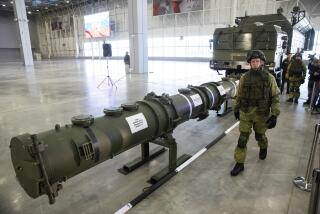Treaties: Honor and Dishonor
- Share via
Among other things, the 1979 arms-control treaty, SALT II, limited the United States and the Soviet Union to 1,200 land- or sea-based multiwarhead missiles each. It also allowed each side to deploy no more than one new land-based intercontinental ballistic missile. The agreement was never ratified by the U.S. Senate, but the Reagan Administration and the Kremlin agreed in 1981 to abide by its provisions anyway.
President Reagan said recently that Moscow had violated the treaty and that within a few months he would have to decide “whether we join them in violating the restraints.” Meanwhile, the 1972 ABM missile defense treaty, which severely limited deployment of strategic missiles by both sides, is also threatened.
Seeming Soviet violation or circumvention of treaty terms is indeed troublesome. At this point, however, U.S. efforts should concentrate on salvaging worthwhile provisions of the two treaties instead of tearing them up.
The problem is being brought to a head by the deployment of new missile-firing submarines--the Trident, in the case of the United States, which carries 24 nuclear missiles. When the seventh new Trident begins sea trials next fall, this country will bump up against SALT II’s 1,200-launcher ceiling. To stay within the ceiling, the Administration must dismantle an older Poseidon submarine or 14 land-based Minuteman 3 missiles. The President is under pressure from some quarters to allow SALT II to expire on schedule at the end of 1985, then ignore the treaty’s restraints.
The Soviets have behaved badly. According to Reagan, they have not dismantled older missile-firing submarines as new ones have come along, but have converted them to cruise-missile carriers instead. They have built a radar complex near Krasnoyarsk, in central Siberia, that most experts agree will violate the ABM treaty when and if it becomes operational.
They also seem to be playing games with the limitation on new offensive missiles. U.S. experts see evidence, though no proof, that strategic SS-16 missiles are being deployed disguised as SS-20s, which are not covered by SALT II. The Soviets are reported to have test-fired the SS-20 missile itself on a track aimed squarely at the United States. Finally, the Pentagon says that the Soviets have built two new offensive missiles instead of the one allowed. The Soviets deny it, but it’s a bad sign that nearly all telemetry data transmitted in their recent missile tests have been encoded.
The Kremlin should understand that if this behavior pattern persists the arms-control negotiating process itself will collapse; in the long run a double standard is absolutely unacceptable.
But the abandonment of either the ABM or the SALT II treaty would not be peaches and cream for the United States, either. Except for the SALT II limitation of 10 warheads per ICBM, the Soviets could be loading two to three times that many warheads on their heaviest missiles. And if the ABM treaty is broken, the Soviets could deploy a large ABM system faster than we could.
The Administration should honor both treaties at least until new arms-control negotiations give a clearer reading of Moscow’s intentions.
More to Read
Sign up for Essential California
The most important California stories and recommendations in your inbox every morning.
You may occasionally receive promotional content from the Los Angeles Times.










